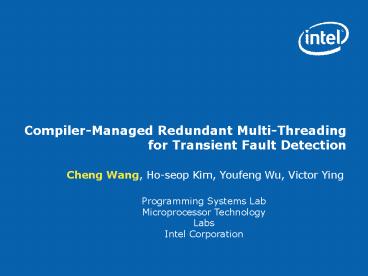CompilerManaged Redundant MultiThreading for Transient Fault Detection - PowerPoint PPT Presentation
Title:
CompilerManaged Redundant MultiThreading for Transient Fault Detection
Description:
Leading Thread. Trailing Thread. Sphere of Replication. Repeatable Operations. Replication 1 ... { Leading thread. trailing thread. main. main. foo. bar. bar. foo ... – PowerPoint PPT presentation
Number of Views:73
Avg rating:3.0/5.0
Title: CompilerManaged Redundant MultiThreading for Transient Fault Detection
1
Compiler-Managed Redundant Multi-Threading for
Transient Fault Detection
- Cheng Wang, Ho-seop Kim, Youfeng Wu, Victor Ying
Programming Systems Lab Microprocessor Technology
Labs Intel Corporation
2
Motivation
- Modern processors are becoming increasingly more
susceptible to transient hardware faults - Hardware-based Redundant Multi-Threading (HRMT)
- Hardware replication for redundant thread
execution - Hardware complexity and cost
- Software-based Redundant Multi-Threading (SRMT)
- Cost effective
- No special hardware for reasonably high error
coverage - Flexible
- Different reliability for different applications
and different codes - Compiler analysis and optimization
- Competitive performance to HRMT
3
Contributions
- First software-based redundant multi-threading
- Handle non-determinism caused by data racing on
shared memory access - Novel code generation techniques for SRMT
- Integrate redundant code and non-redundant code
in the same application - Novel compiler analysis and optimizations for
SRMT - Fail-stop memory access and non fail-stop memory
access
4
Outline
- Software Redundant Multi-Threading
- Compiler Analysis, Code Generation and
Optimizations - Experimental Results
- Related Work
- Conclusion
5
Software-based Redundant Multi-Threading
Leading Thread
Trailing Thread
Sphere of Replication
Replication 1
Replication 2
Replicate
Repeatable Operations
Repeatable Operations
Compare
Non-Repeatable Operations
6
Redundancy Model
- Non Repeatable Operations
- Shared memory access
- System calls
- Legacy binary functions
- Replication
- loaded values of shared memory load
- Return values of legacy binary functions and
system calls - Comparison
- Values to be stored into shared memory
- Addresses of shared memory load and store
- Parameters passed to legacy binary functions and
system calls
7
Replication Example
8
Non-shared memory access
9
Comparison Example
10
Compiler Analysis and Optimizations
- Shared memory access and non-shared memory access
- No communication and comparison overhead for
non-shared memory access - Fail-stop memory access and non fail-stop memory
access - No round-trip communication overhead for non
fail-stop memory accesses
11
Legacy Binary Functions (System Calls)
Leading thread
trailing thread
main
main
foo
bar
bar
foo
main
main
12
Experiments Setup
- SRMT Compiler
- Intel Compiler v9.0, -O3
- Target System
- An internal CMP simulator with on-chip
communication queue - 8-way IBM eServer xSeries 445, 2.2GHz Xeon, Linux
2.4.20 - SPEC CPU2000
- All library are treated as legacy binary function
- MinneSPEC input for simulator run
- MinneSPEC input for error coverage statistic
- Reference input for communication bandwidth
- Reference input for real machine run
13
Error Coverage with Instrumented Error
- Without SRMT SDC 5.8(INT), 12.6(FP)
- With SRMT SDC 0.02(INT), 0.4(FP)
14
Performance on CMP Simulator
- With on-chip communication queue 19 slow down
- With shared L2 cache 2.86X slow down
15
Communication Bandwidth
- Average bandwidth demand 0.6 Bytes/Cycle
- 88 reduction compared to Hardware RMT (5.2
Bytes/cycle)
16
Related Works
- Hardware-based Redundant Multi-Threading
- Reinhardt, ISCA00, Vijaykumar, ISCA02,
Mukherjee, ISCA02, Gomaa, ISCA03 - Lightweight Redundant Multi-Threading
- Gomma,ISCA05, Wang, DSN05, Reddy,
ASPLOS06, Parashar, ASPLOS06 - Instruction Level Software-based Transient Fault
Detection - Reis, CGO05, Reis, ISCA05, Borin, CGO06
- Process Level Fault Tolerance
- Murray, HPL98
- Fast Inter-Core (Inter-Thread) Communication
- Tasi, PACT96, Ottoni, ISCA05, Shetty, IBM
RD06, Rangan, MICRO06
17
Conclusion and Future Work
- We developed a compiler-managed software-based
redundant multi-threading for transient fault
detection - SRMT reduce design and validation complexity in
Hardware-based RMT. - We allow flexible reliability by linking code
with SRMT and binary code without SRMT. - Compiler analysis and optimization reduce 88
communication bandwidth demands. Performance slow
down is only 19. - We achieve error coverage rate of 99.98 for INT
and 99.6 for FP - Future work
- Error recovery
- Binary translation for SRMT
- Neutron-induced soft-error measurement
18
Questions ?
19
Code Generation for Binary Function
20
Thread Communication
- Shared Software Queue
- Delayed Buffering (DB)
- Lazy Synchronization (LS)
21
Performance on SMT and SMP
- Slow down due to producer-consumer cache
thrashing - 5X on SMT
- 4X on SMP with shared off-chip L4 cache
- 11X on SMP without shared off-chip L4 cache































